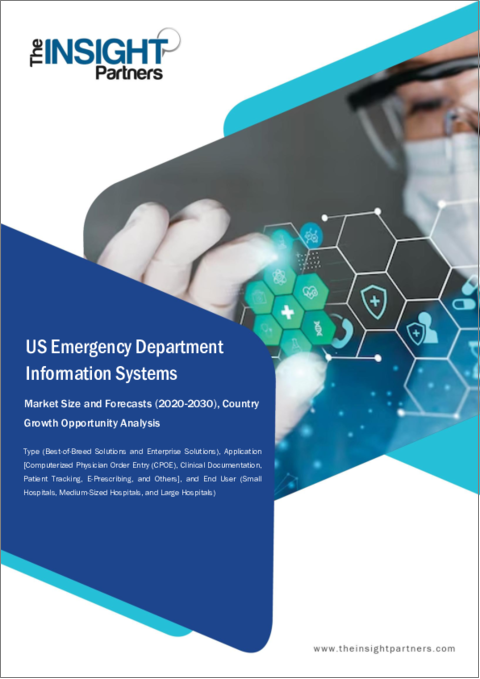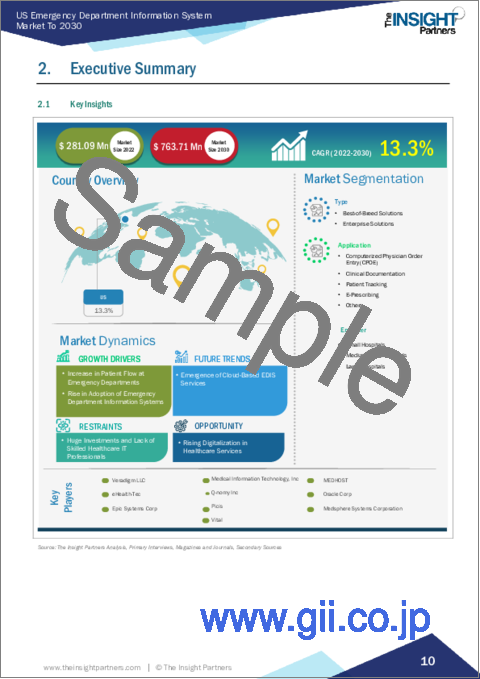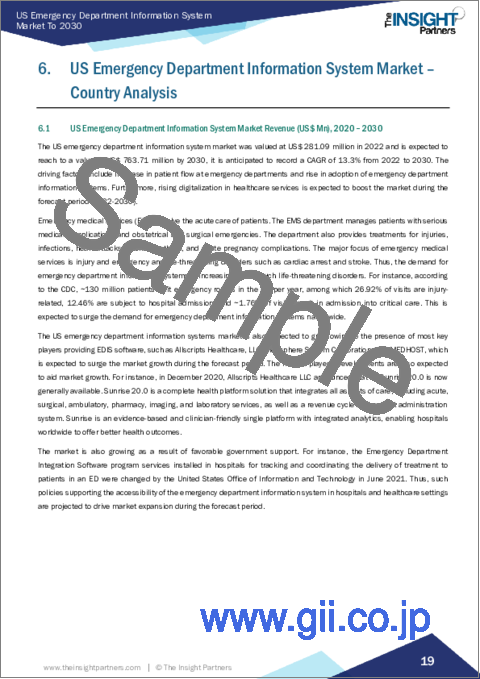|
|
市場調査レポート
商品コード
1372547
米国の救急科情報システム市場規模・予測、地域シェア、動向、成長機会分析レポート対象範囲:タイプ別、用途別、エンドユーザー別、国別US Emergency Department Information System Market Size and Forecasts, Regional Share, Trends, and Growth Opportunity Analysis Report Coverage: By Type ; Application, End User, and Country |
||||||
|
|||||||
| 米国の救急科情報システム市場規模・予測、地域シェア、動向、成長機会分析レポート対象範囲:タイプ別、用途別、エンドユーザー別、国別 |
|
出版日: 2023年10月03日
発行: The Insight Partners
ページ情報: 英文 64 Pages
納期: 即納可能
|
- 全表示
- 概要
- 図表
- 目次
米国の救急科情報システム市場は、2022年の2億8,100万米ドルから2030年には7億6,300万米ドルに達すると予測され、2022年から2030年までのCAGRは13.31%で成長すると予測されます。
救急科における患者数の増加や救急科情報システムの導入促進などの要因が、米国の救急科情報システム市場の成長を促進すると予想されます。しかし、巨額の投資と熟練した医療の不足が、米国の救急科情報システム市場の成長を阻害する可能性があります。
クラウドベースのEDISサービスの登場が今後の米国救急科情報システム市場を押し上げる
クラウドベースの医療情報サービスを利用してケアサービスのコスト効率を高めることは、患者中心の医療サービスとシステムの相互運用性への注目の高まりから、医療提供者の間で支持を集めています。例えば、Shannon Health社は、PeraHealth社の最新の臨床意思決定支援技術を導入した後、2021年12月に救急治療室で使用する「RI Triage」を導入しました。クラウド・コンピューティングは、エンドユーザーのニーズを満たすための、スケーラブルでインターネットベースのリアルタイム・アプリケーションやリソースを提供する情報技術の「新たなパラダイム」となっています。緊急状態の患者に対応するためのクラウドベースの医療・アプリケーションは、一元化されたクラウド・データベースに、個人の病歴が1つの要約された文書に記載されています。患者の病歴は、事故や緊急事態における重要な手術を開始する前に、クラウドデータベースから検索することができます。このようなシステムは、国が所有する固有のID番号システムとも統合できます。救急科はデータにアクセスし、患者の到着予定時刻を確認し、患者の到着状況を更新することができます。
米国の救急科情報システム市場は、タイプ別にエンタープライズソリューションとベストオブブリードソリューションに区分されます。2022年には、ベスト・オブ・ブリード・ソリューション・セグメントが市場の最大シェアを占めると思われます。エンタープライズ・ソリューション分野は、2022年に同市場で最大のシェアを占めると見られ、同分野は予測期間中に同市場で最も高いCAGRを記録すると予測されています。
エンタープライズ・ソリューションは、データを同期させて単一のデータベースを作成する集中分散アーキテクチャにより、プロバイダーの支店や複数の法人を統合します。このソリューションは、WHO、医療法的要件、保険要件に準拠しています。クラウドベースのシステムで、ユーザーはいつでもどこからでもリアルタイムのデータにアクセスできます。一元化されたシステムは、エンタープライズソリューションのすべての法的・財務的エンティティを管理し、ビジネスの生産性を高めます。医療におけるビッグデータの利用拡大、EHR/EMRの受け入れ拡大、規制の義務化、患者の電子カルテ保存のための資金調達などが、エンタープライズソリューション分野の成長を後押ししています。
米国の救急科情報システム市場は、用途別に、コンピューターオーダーエントリー(CPOE)、臨床記録、患者追跡、電子処方、その他に区分されます。コンピューターによる医師オーダエントリー(CPOE)分野は、2022年に米国救急科情報システム市場で最大のシェアを占め、同分野は2022~2030年に最も高いCAGRを記録すると予測されています。コンピューターによる医師オーダーエントリー(CPOE)は、外来および入院患者の設定で、医師がコンピューターシステムに医療オーダーを入力するのを支援するソフトウェアツールです。話し言葉(対面または電話)、筆記(紙の処方箋)、ファックスなど、医薬品の注文を記載する多くの古い方法は、CPOEに取って代わられつつあります。ユーザーは、これらのプラットフォームを使って、処方オーダーや検査、紹介、入院、画像診断、治療オーダーを電子的に定義することができます。ITインフラと医療費削減に役立つ情報技術をアップグレードする政府の試みが、CPOE分野の市場を牽引しています。
米国のエンドユーザー別救急科情報システム市場は、小規模病院、中規模病院、大規模病院に区分されます。中規模病院セグメントは、2022年の米国救急科情報システム市場をリードする可能性が高いです。2022~2030年の予測期間中も同セグメントが優位を占めると予想されます。病院はEDISやEHRなどの情報技術に投資して経費を削減し、医療の質を向上させる。中規模に分類される病院の一般病床と外科病床の数は94~277床です。EHRコンストラクトのさらなる調査によると、モデルから意思決定支援や患者レベルを除外した場合、すべての仮定されたパス間の相関は重要でない結果となっています。さらに調査を進めると、これら2つの変数の存在だけで、一般的な安全性と統計的に意味のある関連性が得られたが、他のすべての経路は重要でないことが判明しました。その結果、中規模の病院は、意思決定支援と患者レベルのデータに焦点を当てた救急科情報システムや電子カルテ技術への投資を考えるべきです。調査によると、これらのアプリケーションは中規模病院の安全性を全体的に向上させることができます。
世界保健機関(WHO)、疾病対策予防センター(CDC)、米国食品医薬品局(FDA)、救急科情報システム(EDIS)、デジタル医療調査(DHR)、食品医薬品安全省(MFDS)などは、米国の救急科情報システム市場に関するレポートを作成する際に参照した一次調査と二次情報の一部です。
目次
第1章 イントロダクション
第2章 エグゼクティブサマリー
- 主要な洞察
第3章 調査手法
- 調査範囲
- 2次調査
- 1次調査
第4章 米国救急科情報システム市場- 市場情勢
- 概観
- PEST分析
- 米国のPEST分析
第5章 米国救急科情報システム市場:主要市場力学
- 主な市場促進要因
- 救急科における患者数の増加
- 救急科情報システムの導入増加
- 市場抑制要因
- 莫大な投資と熟練した医療IT専門家の不足
- 市場機会
- 医療サービスにおけるデジタル化の進展
- 今後の動向
- クラウドベースのEDISサービスの登場
- 影響分析
第6章 米国救急科情報システム市場:国別分析
第7章 米国救急科情報システム市場:2030年までの収益と予測:タイプ別
- イントロダクション
- 米国救急科情報システム市場:タイプ別売上高シェア(2022年・2030年)
- ベストオブブリードソリューション
- エンタープライズソリューション
第8章 米国救急科情報システム市場:2030年までの収益と予測:用途別
- イントロダクション
- 米国救急科情報システム市場:用途別売上高シェア(2022年・2030年)
- コンピューターオーダーエントリー(CPOE)
- 臨床文書化
- 患者追跡
- 電子処方
- その他
第9章 米国救急科情報システム市場:2030年までの収益と予測:エンドユーザー別
- イントロダクション
- 米国救急科情報システム市場:エンドユーザー別売上高シェア(2022年・2030年)
- 小規模病院
- 中規模病院
- 大規模病院
第10章 米国救急科情報システム市場:業界情勢
- イントロダクション
- 米国救急科情報システム市場の成長戦略
- 有機的成長戦略
- 概要
- 無機的成長戦略
- 概要
第11章 企業プロファイル
- Veradigm LLC
- eHealth-Tec
- Epic Systems Corp
- Medical Information Technology, Inc.
- Q-nomy Inc
- Picis
- Vital
- Medsphere Systems Corporation
- MEDHOST
- Oracle Corp
第12章 付録
List Of Tables
- Table 1. US Emergency Department Information System Market, By Type - Revenue and Forecast to 2030 (US$ Million)
- Table 2. US Emergency Department Information System Market, By Application - Revenue and Forecast to 2030 (US$ Million)
- Table 3. US Emergency Department Information System Market, By End User - Revenue and Forecast to 2030 (US$ Million)
- Table 4. Recent Organic Growth Strategies in US Emergency Department Information System Market
- Table 5. Recent Inorganic Growth Strategies in the US Emergency Department Information System Market
- Table 6. Glossary of Terms
List Of Figures
- Figure 1. US Emergency Department Information System Market Segmentation
- Figure 2. US: PEST Analysis
- Figure 3. US Emergency Department Information System Market: Key Industry Dynamics
- Figure 4. Impact Analysis of Drivers and Restraints
- Figure 5. US Emergency Department Information System Market - Revenue Forecast and Analysis - 2020-2030
- Figure 6. US Emergency Department Information System Market Revenue Share, by Type, 2022 & 2030 (%)
- Figure 7. Best-Of-Breed Solutions: Emergency Department Information System Market - Revenue and Forecast to 2030 (US$ Million)
- Figure 8. Enterprise Solutions: Emergency Department Information System Market - Revenue and Forecast to 2030 (US$ Million)
- Figure 9. US Emergency Department Information System Market Revenue Share, by Application, 2022 & 2030 (%)
- Figure 10. Computerized Physician Order Entry: Emergency Department Information System Market - Revenue and Forecast to 2030 (US$ Million)
- Figure 11. Clinical Documentation: Emergency Department Information System Market - Revenue and Forecast to 2030 (US$ Million)
- Figure 12. Patient Tracking: Emergency Department Information System Market - Revenue and Forecast to 2030 (US$ Million)
- Figure 13. E-Prescribing: Emergency Department Information System Market - Revenue and Forecast to 2030 (US$ Million)
- Figure 14. Others: Emergency Department Information System Market - Revenue and Forecast to 2030 (US$ Million)
- Figure 15. US Emergency Department Information System Market Revenue Share, by End User, 2022 & 2030 (%)
- Figure 16. Small Hospitals: Emergency Department Information System Market - Revenue and Forecast to 2030 (US$ Million)
- Figure 17. Medium-Sized Hospitals: Emergency Department Information System Market - Revenue and Forecast to 2030 (US$ Million)
- Figure 18. Large Hospitals: Emergency Department Information System Market - Revenue and Forecast to 2030 (US$ Million)
- Figure 19. Growth Strategies in US Emergency Department Information System Market
The US Emergency Department Information System Market is projected to reach US$ 0.763 billion by 2030 from US$ 0.281 billion in 2022; it is expected to grow at a CAGR of 13.31% from 2022 to 2030.
Factors such as increased patient flow at emergency departments and the adoption of emergency department information systems propel are expected to drive the US emergency department information system market growth. However, the huge investments and lack of skilled healthcare may hinder the US emergency department information system market growth.
Emergence of Cloud-Based EDIS Services to Boost the US Emergency Department Information System Market in Future
The use of cloud-based healthcare information services to increase the cost-efficiency of care services is gaining traction among healthcare providers due to an increased focus on patient-centered health services and system interoperability. For instance, Shannon Health introduced "RI Triage" for use in emergency rooms in December 2021 after deploying the most recent clinical decision support technology from PeraHealth. Cloud computing has become an "emerging paradigm" in information technology for scalable, internet-based, real-time applications and resources to satisfy end users' needs. Cloud-based healthcare applications meant to serve patients in emergency conditions involve centralized cloud databases fed with individuals' medical histories mentioned in a single summarized document. The patient's medical history can be retrieved from the cloud database before starting any crucial operation in any accident or emergency. Such systems can also be integrated with state-owned unique identification number systems. Emergency departments can then access the data, view upcoming patient arrival times, and update patient arrival statuses.
Based on type, the US emergency department information system market is segmented into enterprise solutions and best-of-breed solutions. The best-of-breed solutions segment will likely hold the market's largest share in 2022. The enterprise solutions segment is likely to hold the largest share of the market in 2022 and the same segment is anticipated to register the highest CAGR in the market during the forecast period.
Enterprise solutions integrate a provider's branches and multiple legal entities through a centralized and distributed architecture in which data is synchronized to create a single database. The solution complies with the WHO, healthcare legal requirements, and insurance requirements. It is a cloud-based system that allows users to access real-time data from anywhere at any time. A centralized system manages all legal and financial entities in the enterprise solution, which makes business productive. The expanding usage of big data in healthcare, increasing acceptance of EHR/EMR, regulatory mandates, and financing for the preservation of electronic patient health records are propelling the enterprise solutions segment growth.
The US emergency department information system market, by application, is segmented into computerized physician order entry (CPOE), clinical documentation, patient tracking, e-prescribing, and others. The computerized physician order entry (CPOE) segment held the largest share of US emergency department information system market in 2022 and same segment is anticipated to register the highest CAGR during 2022-2030. Computerized physician order entry (CPOE) is a software tool that assists doctors in entering medical orders into computer systems in ambulatory and inpatient settings. Many old ways of enlisting medicine orders, including spoken (in person or over the phone), written (paper prescriptions), and fax, are being replaced by CPOE. Users can define prescription orders and laboratory, referral, admission, imaging, and treatment orders electronically using these platforms. Government attempts to upgrade the IT infrastructure and information technology that aids in lowering healthcare expenses are driving the market for the CPOE segment.
US emergency department information system market by end user is segmented into small hospitals, medium-sized hospitals, and large hospitals. The medium-sized hospitals segment will likely lead the US emergency department information systems market in 2022. The same segment is expected to dominate during the forecast period 2022-2030. Hospitals invest in information technology such as EDIS and EHR to lower expenses and improve care quality. Hospitals classified as medium-sized have between 94 and 277 general and surgical beds. The removal of decision support or patient level from the model resulted in insignificant correlations between all postulated paths, according to further study of the EHR construct. Further research revealed that the presence of these two variables alone resulted in a statistically meaningful association with general safety, whereas all other routes were found to be insignificant. As a result, medium-sized hospitals should think about investing in emergency department information systems or electronic health record technologies that focus on decision support and patient-level data. According to the research, these applications can improve overall safety in medium-sized hospitals.
The World Health Organization (WHO), Centers for Disease Control and Prevention (CDC), US Food and Drug Administration (FDA), Emergency Department Information Systems (EDIS), Digital Healthcare Research (DHR) and Ministry of Food and Drug Safety (MFDS) are among some of the primary and secondary sources referred to while preparing the report on the US emergency department information system market.
Reasons to Buy:
- Save and reduce time carrying out entry-level research by identifying the growth, size, leading players, and segments in the US Emergency Department Information System Market.
- Highlights key business priorities in order to assist companies to realign their business strategies.
- The key findings and recommendations highlight crucial progressive industry trends in the US Emergency Department Information System Market, thereby allowing players across the value chain to develop effective long-term strategies.
- Develop/modify business expansion plans by using substantial growth offering developed and emerging markets.
- Scrutinize in-depth global market trends and outlook coupled with the factors driving the US Emergency Department Information System Market, as well as those hindering it.
- Enhance the decision-making process by understanding the strategies that underpin security interest with respect to client products, segmentation, pricing, and distribution.
Table Of Contents
1. Introduction
- 1.1 The Insight Partners Research Report Guidance
- 1.2 Market Segmentation
2. Executive Summary
- 2.1 Key Insights
3. Research Methodology
- 3.1 Coverage
- 3.2 Secondary Research
- 3.3 Primary Research
4. US Emergency Department Information System Market - Market Landscape
- 4.1 Overview
- 4.2 PEST Analysis
- 4.2.1 US PEST Analysis
5. US Emergency Department Information System Market - Key Market Dynamics
- 5.1 Key Market Drivers
- 5.1.1 Increase in Patient Flow at Emergency Departments
- 5.1.2 Rise in Adoption of Emergency Department Information Systems
- 5.2 Market Restraints
- 5.2.1 Huge Investments and Lack of Skilled Healthcare IT Professionals
- 5.3 Market Opportunities
- 5.3.1 Rising Digitalization in Healthcare Services
- 5.4 Future Trends
- 5.4.1 Emergence of Cloud-Based EDIS Services
- 5.5 Impact Analysis
6. US Emergency Department Information System Market - Country Analysis
- 6.1 US Emergency Department Information System Market Revenue (US$ Mn), 2020 - 2030
7. US Emergency Department Information System Market - Revenue and Forecast to 2030 - by Type
- 7.1 Overview
- 7.2 US Emergency Department Information System Market Revenue Share, by Type, 2022 & 2030 (%)
- 7.2.1.1 US Emergency Department Information System Market, By Type, 2020-2030 (US$ Million)
- 7.3 Best-of-Breed Solutions
- 7.3.1 Overview
- 7.3.2 Best-of-Breed Solutions: Emergency Department Information System Market - Revenue and Forecast to 2030 (US$ Million)
- 7.4 Enterprise Solutions
- 7.4.1 Overview
- 7.4.2 Enterprise Solutions: Emergency Department Information System Market - Revenue and Forecast to 2030 (US$ Million)
8. US Emergency Department Information System Market - Revenue and Forecast to 2030 - by Application
- 8.1 Overview
- 8.2 US Emergency Department Information System Market Revenue Share, by Application, 2022 & 2030 (%)
- 8.2.1.1 US Emergency Department Information System Market, By Application, 2020-2030 (US$ Million)
- 8.3 Computerized Physician Order Entry (CPOE)
- 8.3.1 Overview
- 8.3.2 Computerized Physician Order Entry: Emergency Department Information System Market - Revenue and Forecast to 2030 (US$ Million)
- 8.4 Clinical Documentation
- 8.4.1 Overview
- 8.4.2 Clinical Documentation: Emergency Department Information System Market - Revenue and Forecast to 2030 (US$ Million)
- 8.5 Patient Tracking
- 8.5.1 Overview
- 8.5.2 Patient Tracking: Emergency Department Information System Market - Revenue and Forecast to 2030 (US$ Million)
- 8.6 E-Prescribing
- 8.6.1 Overview
- 8.6.2 E-Prescribing: Emergency Department Information System Market - Revenue and Forecast to 2030 (US$ Million)
- 8.7 Others
- 8.7.1 Overview
- 8.7.2 Others: Emergency Department Information System Market - Revenue and Forecast to 2030 (US$ Million)
9. US Emergency Department Information System Market - Revenue and Forecast to 2030 - by End User
- 9.1 Overview
- 9.2 US Emergency Department Information System Market Revenue Share, by End User, 2022 & 2030 (%)
- 9.2.1.1 US Emergency Department Information System Market, By End User, 2020-2030 (US$ Million)
- 9.3 Small Hospitals
- 9.3.1 Overview
- 9.3.2 Small Hospitals: Emergency Department Information System Market - Revenue and Forecast to 2030 (US$ Million)
- 9.4 Medium-Sized Hospitals
- 9.4.1 Overview
- 9.4.2 Medium-Sized Hospitals: Emergency Department Information System Market - Revenue and Forecast to 2030 (US$ Million)
- 9.5 Large Hospitals
- 9.5.1 Overview
- 9.5.2 Large Hospitals: Emergency Department Information System Market - Revenue and Forecast to 2030 (US$ Million)
10. US Emergency Department Information System Market - Industry Landscape
- 10.1 Overview
- 10.2 Growth Strategies in US Emergency Department Information System Market
- 10.3 Organic Growth Strategies
- 10.3.1 Overview
- 10.4 Inorganic Growth Strategies
- 10.4.1 Overview
11. COMPANY PROFILES
- 11.1 Veradigm LLC
- 11.1.1 Key Facts
- 11.1.2 Business Description
- 11.1.3 Products and Services
- 11.1.4 Financial Overview
- 11.1.5 SWOT Analysis
- 11.1.6 Key Developments
- 11.2 eHealth-Tec
- 11.2.1 Key Facts
- 11.2.2 Business Description
- 11.2.3 Products and Services
- 11.2.4 Financial Overview
- 11.2.5 SWOT Analysis
- 11.2.6 Key Developments
- 11.3 Epic Systems Corp
- 11.3.1 Key Facts
- 11.3.2 Business Description
- 11.3.3 Products and Services
- 11.3.4 Financial Overview
- 11.3.5 SWOT Analysis
- 11.3.6 Key Developments
- 11.4 Medical Information Technology, Inc.
- 11.4.1 Key Facts
- 11.4.2 Business Description
- 11.4.3 Products and Services
- 11.4.4 Financial Overview
- 11.4.5 SWOT Analysis
- 11.4.6 Key Developments
- 11.5 Q-nomy Inc
- 11.5.1 Key Facts
- 11.5.2 Business Description
- 11.5.3 Products and Services
- 11.5.4 Financial Overview
- 11.5.5 SWOT Analysis
- 11.5.6 Key Developments
- 11.6 Picis
- 11.6.1 Key Facts
- 11.6.2 Business Description
- 11.6.3 Products and Services
- 11.6.4 Financial Overview
- 11.6.5 SWOT Analysis
- 11.6.6 Key Developments
- 11.7 Vital
- 11.7.1 Key Facts
- 11.7.2 Business Description
- 11.7.3 Products and Services
- 11.7.4 Financial Overview
- 11.7.5 SWOT Analysis
- 11.7.6 Key Developments
- 11.8 Medsphere Systems Corporation
- 11.8.1 Key Facts
- 11.8.2 Business Description
- 11.8.3 Products and Services
- 11.8.4 Financial Overview
- 11.8.5 SWOT Analysis
- 11.8.6 Key Developments
- 11.9 MEDHOST
- 11.9.1 Key Facts
- 11.9.2 Business Description
- 11.9.3 Products and Services
- 11.9.4 Financial Overview
- 11.9.5 SWOT Analysis
- 11.9.6 Key Developments
- 11.10 Oracle Corp
- 11.10.1 Key Facts
- 11.10.2 Business Description
- 11.10.3 Products and Services
- 11.10.4 Financial Overview
- 11.10.5 SWOT Analysis
- 11.10.6 Key Developments
12. Appendix
- 12.1 About The Insight Partners
- 12.2 Glossary of Terms






